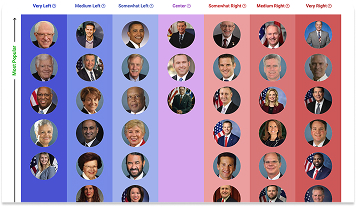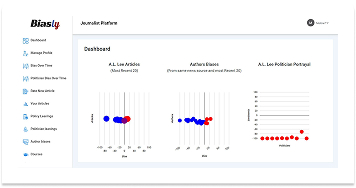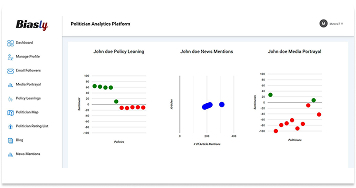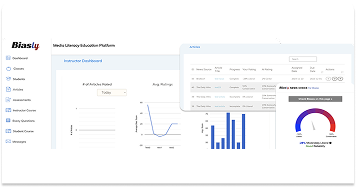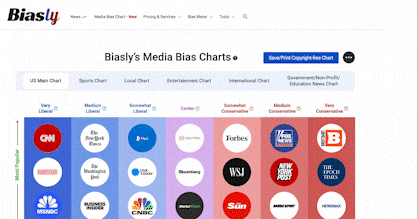Bias Meter
Extremely
Liberal
Very
Liberal
Somewhat Liberal
Center
Somewhat Conservative
Very
Conservative
Extremely
Conservative
-100%
Liberal
100%
Conservative

Biasly determines media bias ratings through a dual-layered approach combining artificial intelligence and analyst review. The platform’s proprietary bias detection engine, Bias Meter, evaluates sentiment, policy position alignment, and language framing across thousands of data points in news articles. Analysts then verify and interpret the AI’s findings, providing additional context where needed. Learn more
- Profile
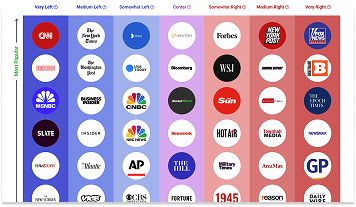
Belfast Live on the media bias chart
Belfast Live has a Bias Score of 10% Center which is based on a variety of factors including its policy and politician leanings, article ratings, and the use of biased language. Its Reliability is rated as Average, and additional analytical insights are available in the other tabs.
- Bias Rating
10% Center
- ReliabilityPolicy Leanings
4% Center
Extremely
LiberalVery
LiberalModerately
LiberalSomewhat Liberal
Center
Somewhat Conservative
Moderately
ConservativeVery
ConservativeExtremely
Conservative-100%
Liberal100%
Conservative
Average Reliability
*Our bias meter rating uses data science including sentiment analysis, machine learning and our proprietary algorithm for determining biases in news articles. Bias scores are on a scale of -100% to 100% with higher negative scores being more liberal and higher positive scores being more conservative and 0% being neutral. The rating is an independent analysis and is not affiliated nor sponsored by the news source or any other organization.
Politician Portrayal24% positive
Continue For Free
Create your free account to see the in-depth bias analytics and more.
By creating an account, you agree to our Terms and Privacy Policy, and subscribe to email updates.
Policy Leanings Analysis
Policy | Bias score |
|---|
Belfast Live Editorial Patterns
Belfast Live’s coverage of political topics often reflects a Center bias, with consistent patterns in phrasing, source selection, and thematic focus that are Neutral. This content analysis examines how Belfast Live handles liberal and conservative issues and evaluates its language choices and editorial tendencies.
Coverage of Liberal vs. Conservative Topics
Belfast Live’s articles include issues like vaccinations, the war between the Israeli–Palestinian conflict, and local Northern Ireland politics. When covering issues like the war in Gaza, Belfast Live often takes a centrist perspective, including multiple ideological perspectives within its articles.
Furthermore, Belfast Live’s coverage of liberal and conservative politicians is balanced. Rather than criticizing either party, both the DUP and SDLP are given coverage that aims to present their respective policy positions as well as the opposing view. For example, the article “Belfast City Hall LGBTQ stained glass window plan to go ahead eight years after proposal” presented quotes from multiple political parties:
- Sinn Féin Councillor Ciaran Beattie: “I think it is seven years this has taken, and I know this wasn’t (council officer’s) fault, as they were hard at work elsewhere. But it was a fairly quick process in the end.”
- Alliance Councillor Sam Nelson: “I think it is a real positive sign for the city that we can recognise the contribution of the LGBT+ community in our city.”
- SDLP Councillor Séamas de Faoite: “I want to thank the officers for their work around this, and the artists who have worked to a very tight turnaround and engaged very extensively with community partners to make sure we get to this point.”
Policy and Issue Framing
When covering issues like parental laws, Belfast Live takes a centrist stance by using neutral language and providing extensive quotes. For example, in its article “MLA insists Justice Bill amendment ‘not a smacking ban’” Belfast Live used more quotes from politicians rather than their own commentary on the issue. This way, readers understand the issue as different politicians frame it, rather than how the news outlet frames it. This is also the case with their coverage of climate change.
Even in neutral coverage, word choices can subtly affect the perception of bias. This consistent choice of words reflects an editorial direction that, even unintentionally, can contribute to bias in news media.
Coverage and Relevance
Belfast Live’s reporting often touches on key issues central to the media bias discussion, like immigration, gender rights, and free speech. As such, it serves as a compelling case study for examining source bias and news media bias in state-focused reporting.
Readers who wish to further explore how Belfast Live compares with other publications can visit Biasly’s Media Bias Chart to analyze tone and word choice in real time.
Belfast Live Bias Analysis
Belfast Live was formed in 2015 and is owned by Reach PLC, a British news publisher. It is dedicated to providing quality and in-depth news to the people of Belfast and Northern Ireland. As a leading local media outlet in Northern Ireland, Belfast Live plays a significant role in shaping public perception. Readers’ trust in the accuracy of local news may mirror the conclusions reached by Biasly’s media bias ratings. This article delves into Belfast Live’s editorial tendencies to explore whether political bias is present and, if so, to what degree.
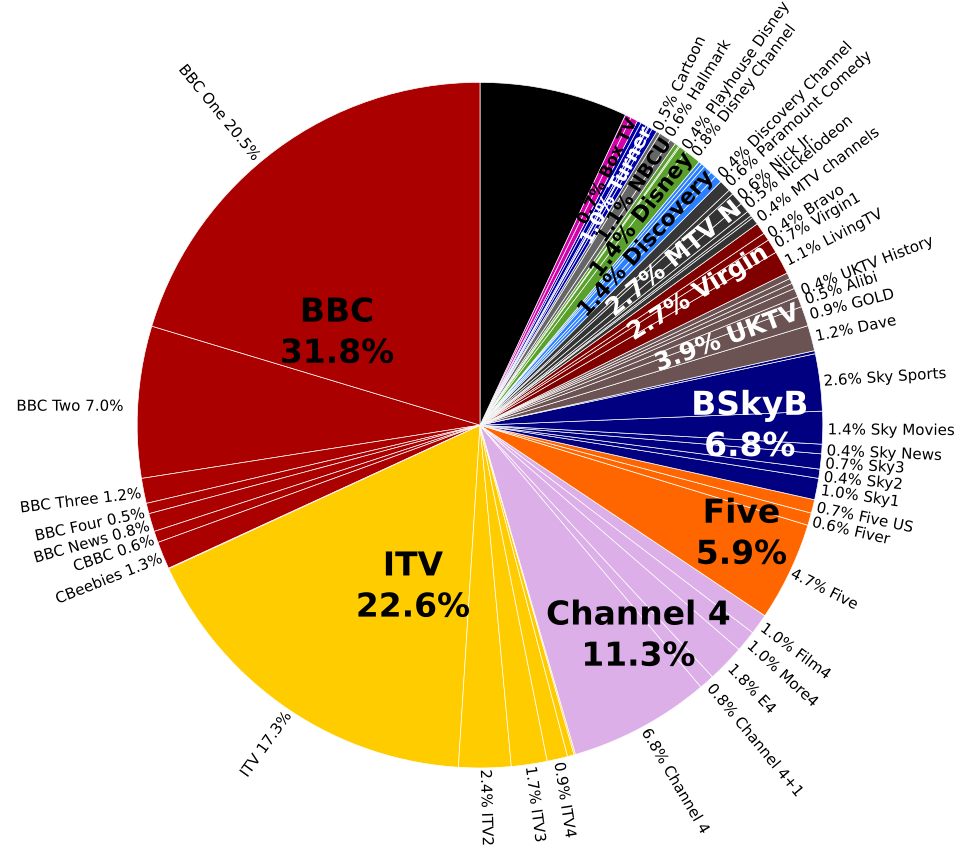
Television Channels in the UK by Viewing Share
Source: Wikimedia Commons
Is Belfast Live Biased?
Based on Biasly’s evaluations, Belfast Live is rated as Center.
By examining content patterns and the broader context of media influence, we aim to offer a balanced perspective on Belfast Live’s political bias.
How Does Biasly Rate News Sources?
Biasly uses proprietary algorithms and a team of analysts to provide comprehensive bias evaluations across thousands of news outlets. Over 200,000 articles from more than 3,200 sources have been analyzed to identify the most accurate and unbiased stories.
Biasly assigns each outlet three key scores:
- Reliability Score – Reflects factual accuracy
- AI Bias Score – Generated via natural language processing
- Analyst Bias Score – Assessed by human political analysts
These scores are based on seven core metrics: Tone, Tendency, Diction, Author Check, Selection/Omission, Expediency Bias, and Accuracy. These elements help analysts and algorithms evaluate the political attitude conveyed by each article.
Biasly’s Bias Meter ranges from -100% (most left) to +100% (most right), with 0% indicating neutrality. The system evaluates individual articles based on political terms, policies, figures, and sentiment to calculate precise bias ratings.
Is Belfast Live Politically Biased?
Belfast Live earns a Center rating for its AI Bias Score and a Center for its Analyst Bias Score. The Analyst Bias Score is generated by reviewers from liberal, moderate, and conservative backgrounds. Analysts reviewed multiple Belfast Live articles and noted a centrist coverage of issues like LGBTQ+ rights, while right-leaning biases on issues like Irish and Northern Irish relations. For example, in the article “MP tells those in Northern Ireland who want to vote in Irish Presidential election they should “move to the Republic””, the article highlights the perspective of Alex Easton, a right-leaning politician, but does not include any other political perspectives.
This Bias score is determined through natural language processing that evaluates the tone, word choice, and opinion embedded in the reporting. Recent AI evaluations highlight centrist narratives in articles discussing the war in Gaza and racial justice issues.
Analysis of Bias in Belfast Live Online Articles
To evaluate bias, we can analyze select Belfast Live articles through several of Biasly’s bias rating criteria: Tone, Tendency, Author, Diction, and Expediency Bias.
- Tone: The overall attitude conveyed by the article
- Diction: Specific word choices made by the writer
- Author: The background and social presence of the journalist
- Tendency: Patterns of bias in the writer’s broader body of work
- Expediency Bias: Quick visual or textual indicators like headlines and photos that imply bias
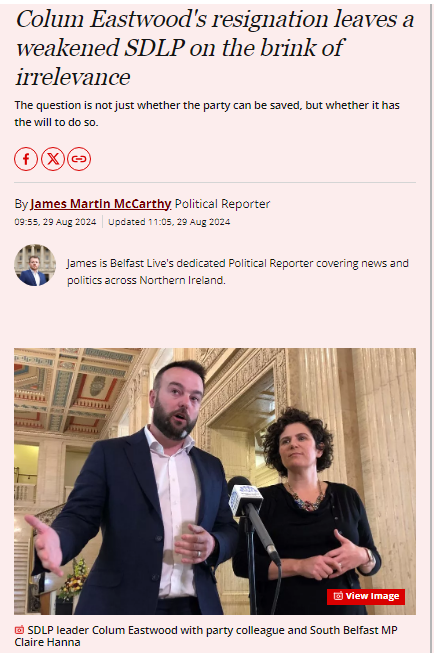
Source: Belfast Live
An example of expediency bias can be seen in the article “Colum Eastwood’s resignation leaves a weakened SDLP on the brink of irrelevance”. While the image above does not signify any political bias, the headline’s usage of terms like “weakened” and “irrelevance” signals a right-leaning bias. Rather than using neutral language to present the issue, the article attempts to sway the reader in a certain direction with its use of biased diction.
An example of an article that lacks bias through diction can be seen in the article “Burke family confront DUP Minister accusing him of ‘promoting LGBTQ+ ideology’ during conference stunt”. Here is a quote from the article:
“In a 16-minute video which the Burkes posted online, the pair can be seen doorstepping the Education Minister whilst holding a sign accusing him of promoting “sodomy”, LGBT consent and “pornography.”
Instead of using inflammatory language to perhaps exaggerate the events, Belfast Live uses neutral language and impartially describes the events as they occurred. This means this article is balanced and covered in a centrist manner.
An example of an article that does not show bias through tone can be seen in the article “Common Travel Area immigration clampdown sees dozens arrested”. Issues like illegal immigration are often controversial, and the general tone of articles on immigration commonly shows some type of bias. However, Belfast Live remains impartial in its tone as they don’t attempt to moralize or criticize policy decisions. Rather, they aim to merely report what has happened and the policy that has been taken on. This indicates the article’s portrayal as centrist.
Looking at an author’s background can also provide insight into their possible biases. For example, here is a tweet from one of Belfast Live’s staff writers, James McCarthy:
SDLPs Claire Hanna MP begins her affirmation in Irish and states she takes it “in hope of a reconciled new Ireland” pic.twitter.com/GA30p0pPXA
— James McCarthy (@JamesMcCarthy97) July 9, 2024
The tweet itself is straightforward, and McCarthy doesn’t use any language that may suggest a certain bias. This suggests that McCarthy, even through his personal social media, attempts to portray political information in a centrist manner.
Looking at an author’s previous articles can also give you a hint as to whether there may be bias in their articles. Here are some of McCarthy’s previous article headlines:
- “Closure of controversial RHI scheme to cost £196 million over next decade”
- “NI parties react as PM announces recognition of Palestinian state”
- “Burke family confront DUP Minister accusing him of ‘promoting LGBTQ+ ideology’ during conference stunt”
None of these titles utilizes any inflammatory language, suggesting that McCarthy likely portrays his articles in a balanced way.
Analysis of Belfast Live Opinion Articles
To fully understand political bias in media, it’s important to distinguish between factual reporting and opinion pieces. While reporting aims to present facts and let readers form their own conclusions, opinion articles express personal viewpoints on current issues. Although the previous section examined factual reporting, this section turns to how bias surfaces through Belfast Live’s selection and tone of opinion content.
The article “’NI politicians are taking the public for fools over proposed MLA pay hike’ – Gerry Carroll” is a good example of how tone and diction can be analyzed in an opinion article in terms of bias. Instead of relying on inflammatory diction, the author presents the different perspectives on this issue and argues, from his perspective, which solution is the best. While a factual article should not aim to argue for a specific solution, because this is an opinion piece, this is not uncommon. However, the fact that the author portrays multiple perspectives and doesn’t rely on inflammatory diction signals that this opinion article is centrist.
Another article that can be considered centrist is “Opinion: Stormont’s Good Jobs Bill is bold, now it must be delivered”. While the author argues from a personal perspective, the tone and diction of the article signify that the main purpose of the article is to be informative. For example, here is a quote from the article:
“Even if it does reach the Assembly floor, this Bill is unlikely to pass unscathed. Once it hits the committee stage, the watering-down process often begins. Clauses get softened, timelines get extended, and exemptions start to multiply. Business lobby groups have already begun circling. A number of groups representing businesses have already stressed that the bill must not be a “burden” on employers and pointed to the economic uncertainty that some businesses are already facing.”
The article seeks to inform the reader about the process of passing a bill into law. Also, notice the lack of inflammatory diction or criticism. For that reason, this article can be considered centrist.
Most of Belfast Live’s opinion pieces follow this similar format. Rather than only presenting one perspective, their opinion articles often engage with perspectives from across the political spectrum, and rarely use inflammatory word choice. In this sense, Belfast Live’s opinion articles can generally be considered centrist. However, it is still important to carefully analyze each article on its own terms.
Who Owns Belfast Live?

Source: Reach PLC
Belfast Live is a for-profit news outlet that was formed in 2015 and is owned by Reach PLC. According to Press Gazette, Belfast Live had an audience of 2.2 million by February 2025, with 39% of Northern Ireland’s online community interacting with them at some point.
How to Evaluate Bias
Although Biasly rates Belfast Live as Center, it’s important to remember that bias can vary from article to article. So, let’s learn how to evaluate media bias.
Recognizing media bias requires awareness and critical thinking. Often, readers trust news sources that affirm their existing beliefs—a psychological tendency known as confirmation bias. This makes it harder to identify slanted narratives or one-sided reporting.
To combat this, it’s essential to challenge your assumptions by consulting multiple viewpoints and verifying news through third-party analysis. Tools like Biasly’s media bias ratings allow readers to compare the same news story across the political spectrum.
Ultimately, bias isn’t always a matter of what is said—it’s also about what is left out, how topics are framed, and which stories are chosen for coverage. Learning to recognize these patterns can help readers make more informed decisions and develop greater media literacy.
To start comparing news outlets and gain a better understanding of bias, sign up for Biasly’s Media Bias & News Analytics Platform to see how stories vary between sources.
Belfast Live Reliability Analysis
Is Belfast Live Reliable?
Biasly gives Belfast Live an “Average” reliability. This suggests that while it generally upholds journalistic standards, its reliability can vary by article. Therefore, it is important to be able to analyze Belfast Live’s reliability within each article.
Further investigation is needed to determine whether bias or other factors are affecting its accuracy. At Biasly, we specialize in evaluating not just bias but also the reliability of media outlets. Let’s explore the accuracy and trustworthiness of Belfast Live.
How to Evaluate Reliability?
Reliability refers to how trustworthy or accurate a news source is. If we can’t trust what we read, then continuing to consume content from that outlet serves little purpose. So how do we evaluate a news outlet’s reliability?
There are several potential measures of reliability to look out for when trying to determine whether a media source is reliable or not. Red flags for an unreliable article can include the presence of wild, unsubstantiated claims, facts dependent on other unreliable sources, heavy use of opinionated language, and more. In contrast, hallmarks of a reliable source include:
- Absence of subjective language
- Citing credible sources (e.g., .gov, .edu, academic references)
- Verifiable facts and statistics from multiple outlets
- Use of primary sources, like interviews or transcripts
- Consistency with coverage across other platforms
Biasly’s reliability scores incorporate these elements in evaluating media outlets.
So How Does Belfast Live Fare in Its Reliability?
The political reliability index developed by Biasly assesses both accuracy and trustworthiness. Belfast Live currently holds Average Reliability Score, which is calculated as a weighted average of:
- Fact Analysis Score – Evaluates the accuracy of claims, facts, and evidence.
- Source Analysis Score – Assesses the number, diversity, and credibility of sources and quotes used.
Belfast Live’s Source Analysis Score is Average at 47% Reliable. This suggests moderate trustworthiness in its sourcing practices. The score is AI-generated and considers quote length, frequency, diversity, and quality.
The Fact Analysis Score is yet to be finalized. This score will further determine how well the Tribune supports its claims, addresses selection and omission bias, and presents verifiable evidence. Until this is available, readers are encouraged to perform their own evaluations using Biasly’s media bias tools.
Belfast Live’s Accuracy and Reliability
According to Biasly’s analysis, Belfast Live maintains Average Reliability Score, but individual articles may vary significantly. Let’s dive into the details.
Two common types of bias that affect factuality include:
- Selection Bias – Highlighting or omitting stories to fit a particular narrative.
- Omission Bias – Leaving out differing perspectives or relevant details to skew perception.
Biasly’s accuracy ratings use a scale from 1% (least accurate) to 100% (most accurate). Factors include the presence of supporting evidence, internal and external reliable sources, and balanced viewpoints.
Analysis of Reliability in Belfast Live’s Online News Articles
Belfast Live aims to provide objective, fact-based reporting. Its staff includes writers from varying ideological backgrounds, which can help balance coverage.
Quality of Sources and Facts Used
Belfast Live often uses credible sources from across the political spectrum, but it often loses reliability due to the low number of sources used in its articles. Take, for example, the article “Closure of controversial RHI scheme to cost £196 million over next decade”. Here are the sources cited for the article:
- Caoimhe Archibald, Economy Minister of Northern Ireland
- Belfast Live, Northern Irish news outlet
- The Renewable Heat Association of Northern Ireland, an organization that represents the renewable heat industry in Northern Ireland
There are six quotes, with five of them being long. Here are some of the quotes in the article:
- Caoimhe Archibald: “Today marks a significant step forward for participants who joined the Scheme in good faith and sets out a clear path to fulfilling the New Decade, New Approach commitment to close the RHI scheme. In providing this pathway toward closure, I must strike a fair and responsible balance — recognising the genuine expectations of those participants who entered the Scheme in good faith, while safeguarding the interests of the taxpayer.”
- The Renewable Heat Association of Northern Ireland: “The Renewable Heat Association welcomes the Minister’s commitment to tackling the RHI issues arising from the 2019 legislation, now recognised by all parties as having unintended negative consequences, and the proposed immediate in-year tariff uplift. This is the first step towards a fair conclusion to the issues and must be seen as progress following six years of paralysis.”
Caoimhe Archibald is considered left-leaning, while Belfast Live is considered right-leaning. The Renewable Heat Association of Northern Ireland is considered to be centrist. While there is mostly an even spread regarding the ideological perspectives represented in this article, there is still a lack of sources. Relying on only three sources and six quotes suggests that the article’s scope is narrow and may not convey the full narrative of the issue.
Contrastedly, the article “Sinn Féin accuse DUP of ‘racism’ during Irish language row” can be considered to be more reliable. Here are the sources cited in the article:
- Sarah Bunting, Councillor for the DUP
- Belfast Live, Northern Irish news outlet
- Ciaran Beattie, Councillor for Sinn Féin
- Dean McCullough, Alderman for the DUP
- Tracy Kelly, Lord Mayor of Belfast and Councillor for the DUP
- Jenna Maghie, Councillor for Alliance
There are ten quotes, with six of them being long. Here are some of the quotes from the article:
- Councillor Ciaran Beattie: “If you look across the water, or to the UK as [the DUP] would call it, you would see in Glasgow there is bilingual [logos] on all the uniforms, if you go to Cardiff and loads of other cities throughout the UK, they have Gaelic on their uniforms, but they don’t like it in Belfast. Why? Because it is Irish.”
- “Alderman McCullough asked Cllr Beattie to stand over his claims that DUP members were “racist”
Sarah Bunting, Belfast Live, Dean McCullough, and Tracy Kelly can all be considered right-leaning. Ciaran Beattie and Jenna Maghie can be considered left-leaning. Compared to the previous article, there are more quotes and sources cited. Furthermore, the ideological diversity of the sources cited is maintained. Therefore, this article can be considered to be mostly reliable.
Selection and Omission Bias
An example of selection bias can be seen in the article “Robinson defends devolution as he warns against consequences of direct rule”. The article only highlights the perspective of DUP leader Gavin Robinson and does not provide any other perspective regarding the issues Robinson touches upon. For example, here are some of the quotes highlighted by the article:
- Gavin Robinson: “But friends, let me say this plainly, those who argue we would be better off with Starmer than with Stormont cannot point to a single area where policy would be better because of a Labour government.”
- “Mr Robinson also voiced support for what he described as Israel’s “just war in Gaza” as he again criticised the Irish government, accusing it of wanting to be “pen pals with Hamas.”
This skews the reader’s perspective on these different issues and signals that the article reflects a right-leaning bias.
An article that has no selection or omission bias is “Lisburn Castlereagh Mayor heralds LGBTQIA+ policy as ‘important first step”. The article cites sources from a range of ideological perspectives and does not highlight one over another. For example, here are some quotes from the article:
- Mayor Kurtis Dickinson: “As a council, this policy should be reflective of our residents. This is an important first step and a great one. Though I would like to see the council build on this policy and not let it become static.”
- Alan Givan: “It would be very wrong if special status or a hierarchy were created. Mr Mayor says that it is a first step, and I am not sure what he means. It could suggest that there were more steps going forward. “If so, then all other groups need to take steps, and that would be a dangerous path to go down. This is a minority group we are talking about. There are about 97% of people who may not hold the same values as the LGBT community. There should be no extra funding or opportunities over others. That is the position my group will hold.”
The article presents the policy position of each perspective and, therefore, lets the reader come to a conclusion on their own.
Another article that does not have selection or omission bias is “Belfast Council stops short of condemning Kneecap”. Like the previous article, this article cites a multitude of different ideological perspectives and does not highlight one over another. Here are some quotes from the article:
- The chamber voted for an SDLP proposal, which condemned “sectarianism in all its forms” and “all threats and acts of violence against political and elected representatives” while rejecting support for “proscribed organisations promoting violence or hate.”
- The DUP proposal put forward last night states: Belfast City Council unreservedly, and unequivocally, condemns the divisive, sectarian, and hate-filled words of Kneecap, not least: ‘The only good Tory is a dead Tory. Kill your local MP’.”
It presents the two opposing policy positions regarding Kneecap and how different politicians responded to it. By not taking sides, the article remains neutral and centrist.
So, Is Belfast Live Reliable?
Overall, Belfast Live can be considered to be an outlet that is moderately reliable. It demonstrates a consistent goal of journalistic integrity and typically supports claims with sources and quotes. Occasional omissions and framing bias do appear, particularly on culturally sensitive or partisan issues.
As media literacy improves, readers can more easily detect issues with selection bias, omission bias, and factuality. To strengthen your ability to assess reliability across the political spectrum, use the News Bias Checker to compare how multiple outlets report the same story.
This empowers you to consume more accurate, balanced, and dependable news.
Additional Insights
News Source Comparison
When it comes to news source comparison, Belfast Live is often evaluated alongside other regional and national outlets that lean right or center-right. Sources like Forbes, Wall Street Journal, and The US Sun often present similar tones and editorial philosophies. While Belfast Live maintains a Center media bias, it differs from strongly partisan sources in that it occasionally includes opposing viewpoints and strives for regional coverage balance.
This puts it in contrast with more biased media outlets that present consistently one-sided narratives without factual counterpoints. Readers seeking balanced political coverage may compare Belfast Live’s framing of issues with outlets rated as center or lean-left on our Media Bias Chart, or explore other regional papers on our Similar Sources page.
Notable Contributors and Authors
Belfast Live features a diverse range of reporters and columnists, many of whom are deeply familiar with Northern Ireland’s political climate. Reporters like James McCarthy and Michael Kenwood frequently cover political controversies from a centrist and balanced perspective.
Related Tools and Resource Pages
To better understand how Belfast Live fits into the broader media landscape, we recommend exploring these helpful resources:
- Media Bias Chart: See where Belfast Live ranks among hundreds of media outlets across the political spectrum.
- Political Bias Chart: Visualize political slants of news sources across various policy areas.
- Journalist Bias Analytics Platform: Explore how individual journalists contribute to bias within their publications.
- Politician Bias Analytics Platform: Compare how politicians are framed differently by Belfast Live and other outlets.
- Media Literacy Education Platform: Learn how to critically assess media sources, bias techniques, and news reliability.
Frequently Asked Questions
Belfast Live is rated as Center based on Biasly’s media bias algorithm, which assesses sentiment, article framing, and policy favorability.
Belfast Live has been cited for misinformation before. For example, it mistakenly used photographs of the wrong person in an article regarding a death on a ferry. While they apologized for the mistake, it does say something about their editing standards. Still, Belfast Live maintains a “Corrections and Clarifications” page to address any published factual inaccuracies, demonstrating a commitment to transparency and rectifying mistakes.
Biasly uses a combination of AI sentiment analysis and human analyst review to assess tone, fact accuracy, source quality, and media bias indicators. Learn more on our Bias Meter page.
Yes. Belfast Live typically upholds fact-based journalism, though occasional partisan framing and selective reporting may impact overall news reliability.
Ratings are based on recent news using data science and A.I. technology.
Military Spending
| Date | Sentiment | Associated Article | Snippet |
|---|---|---|---|
| 08/25/2019 | 75% For | Trump Family Detentions Flores Agreement (link) | So, of course, the Trump administration is doing the opposite in a baldfaced |


























